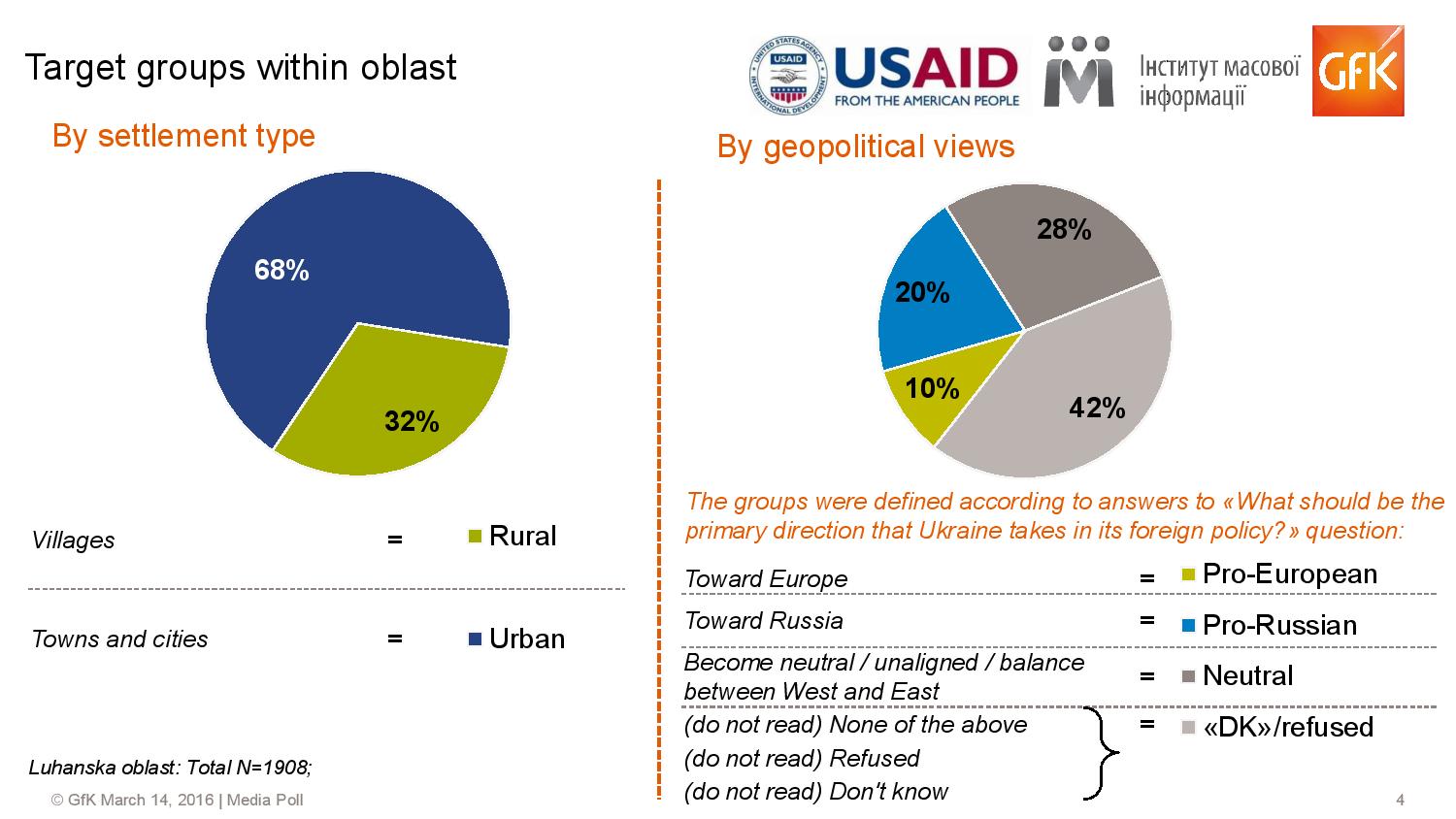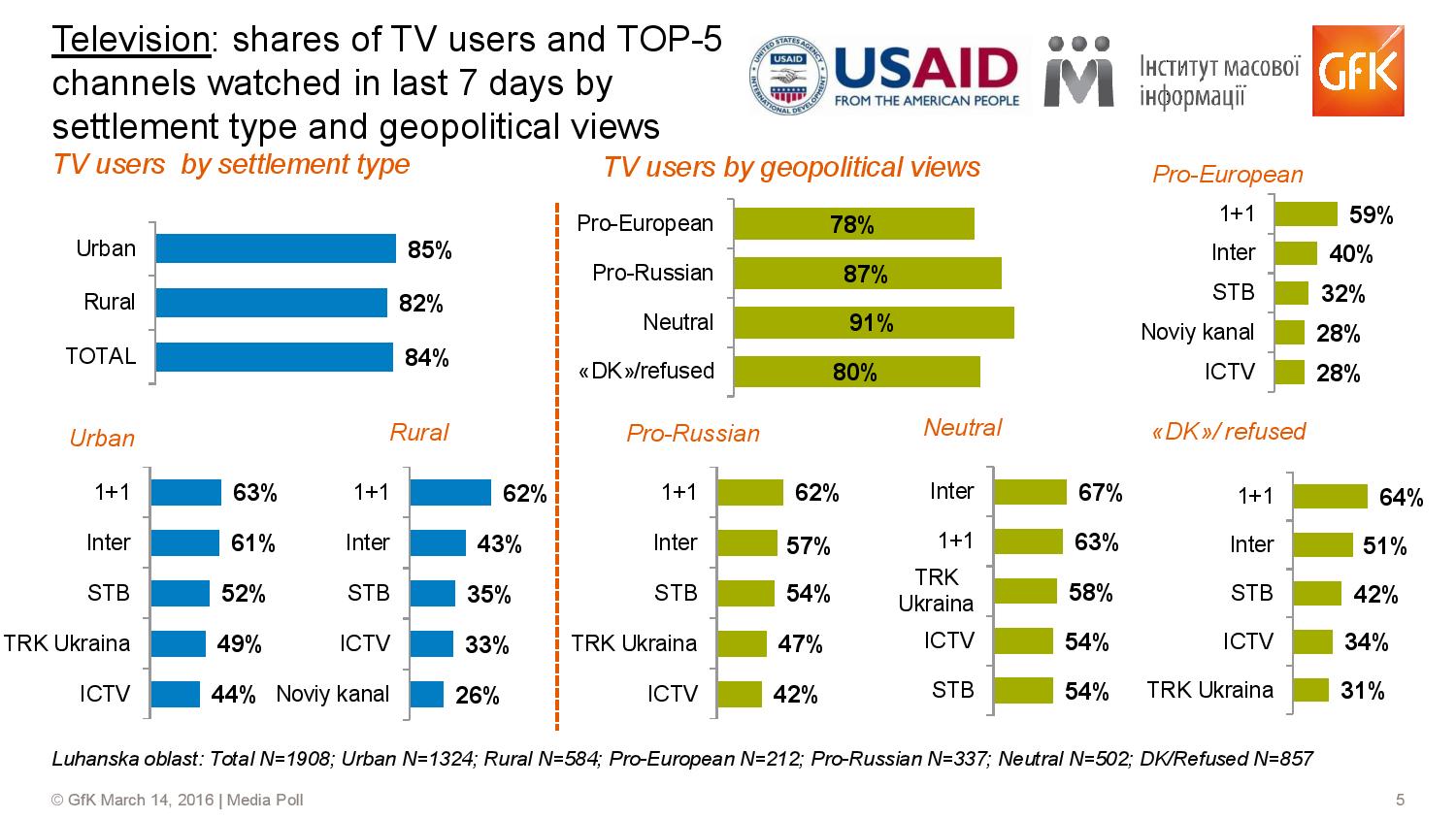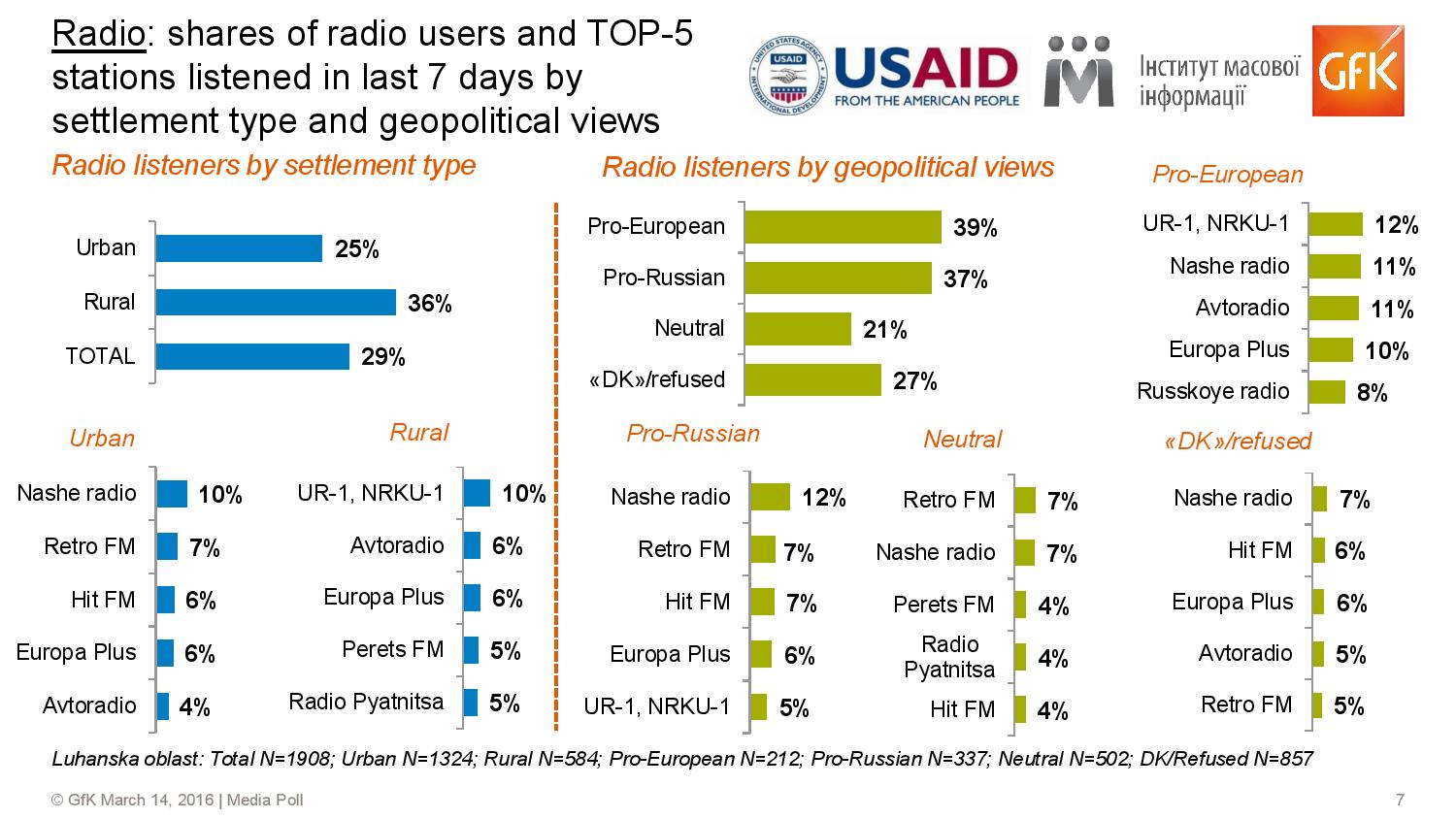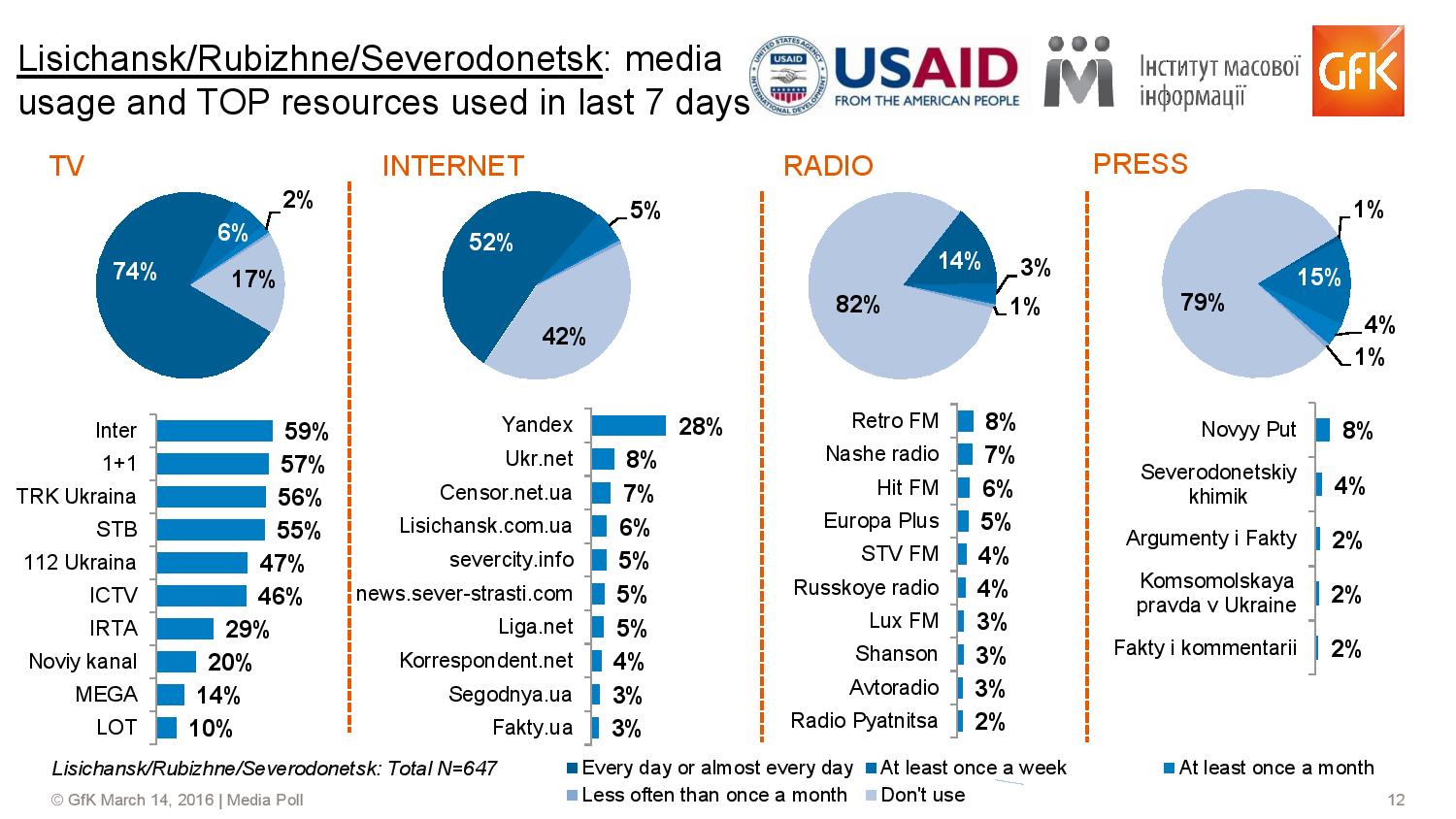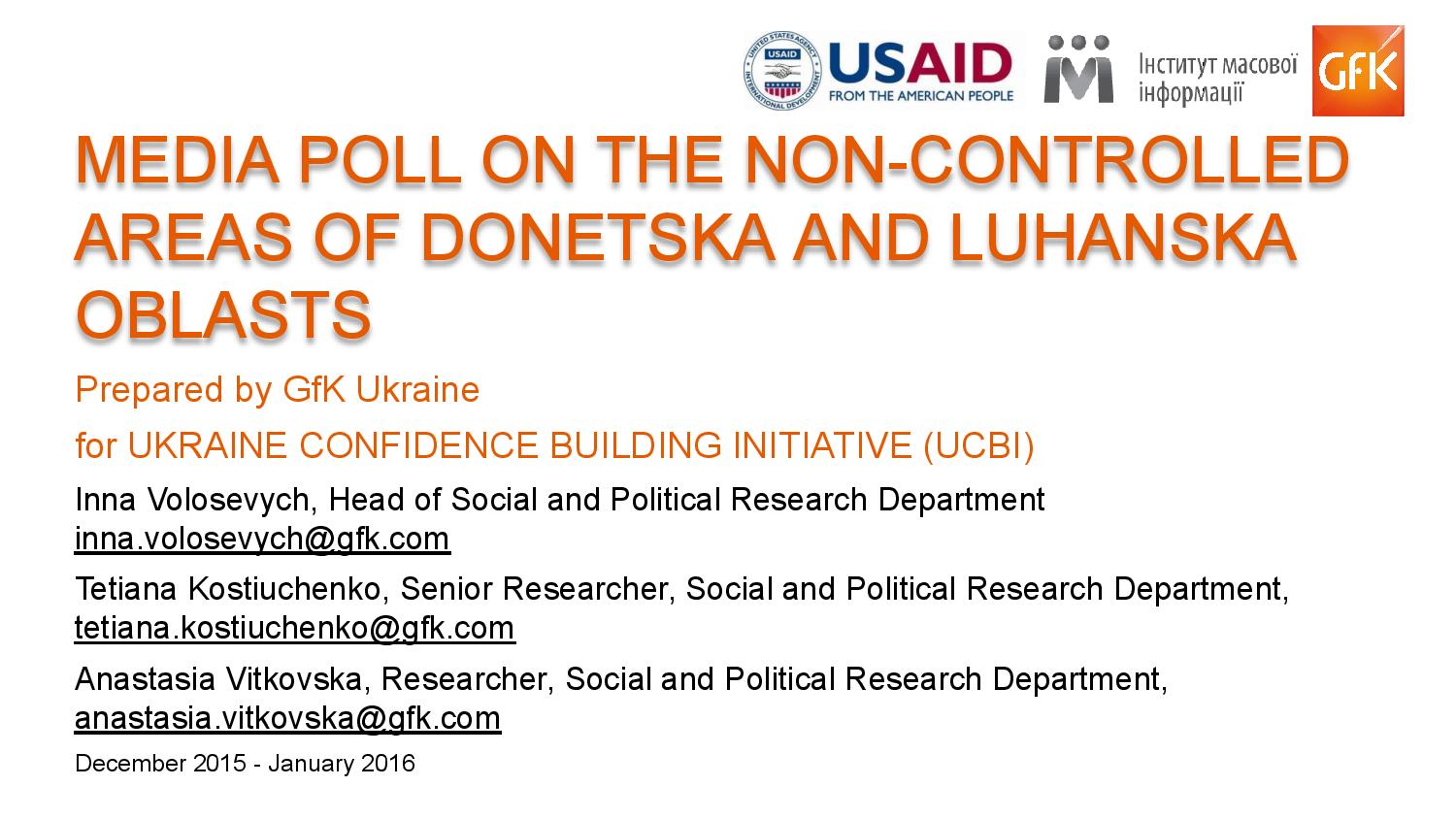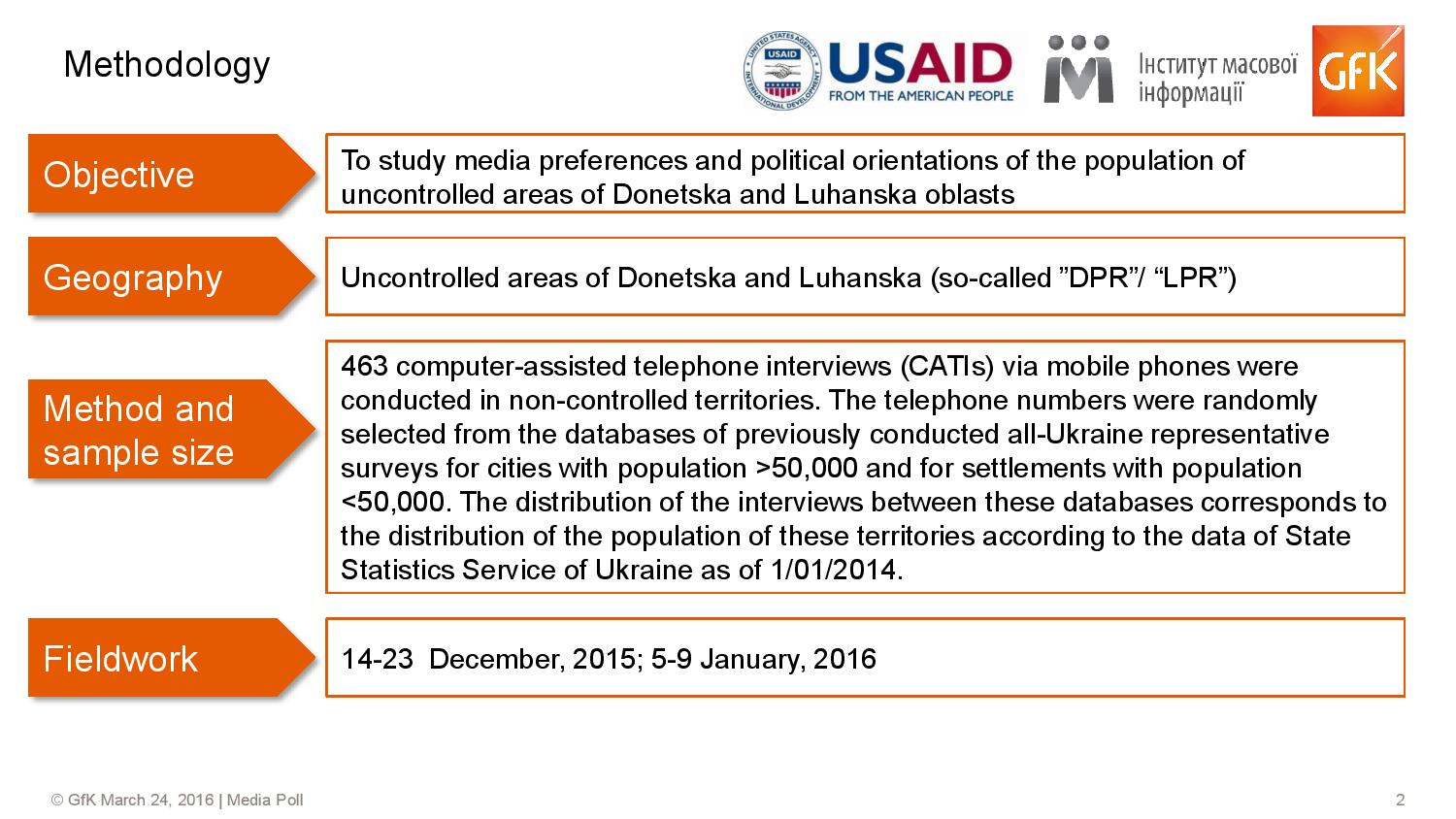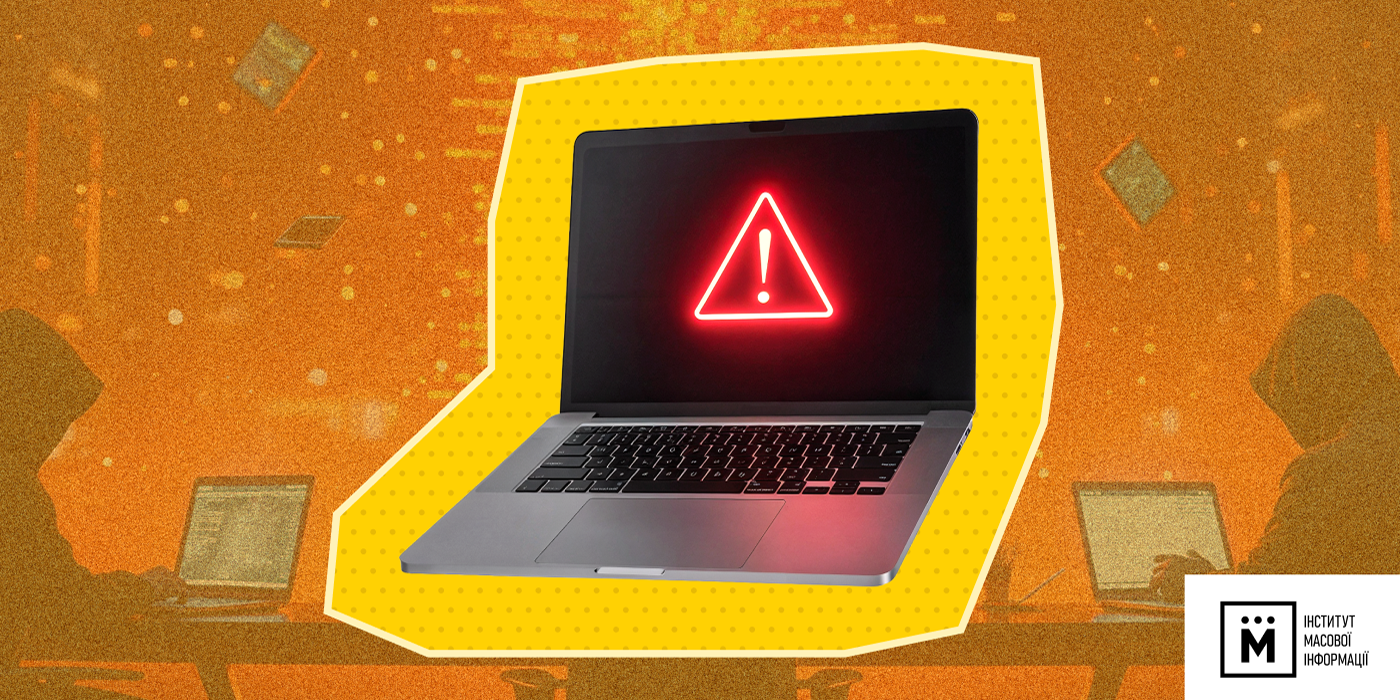Analysis by Institute of Mass Information
MAIN TENDENCIES OF MEDIA SPACE
SITUATION IN THE OCCUPIED TERRITORIES
Before 2014, in Luhanska oblast there were 17 printed media outlets, more than 10 news websites functioned, and in Luhansk itself, three local TV channels operated. After the beginning of the so-called «Russian spring», dozens of journalists fled from the occupied territories due to pressure, and central Ukrainian media outlets were forced to close down their correspondent offices there.
On May 1, 2014, the militants of the so-called «Army of Southern East» captured the Radio and Television Center of Luhansk (a branch of the Ukrainian concern RRT), and started to broadcast Russian TV channels instead of Ukrainian ones. In the beginning of summer of 2014, local cable providers were forced to stop transmitting Ukrainian TV channels; also, the local TV companies LKT, «Irta» and «LOT» (Luhansk Oblast Television) were closed.
As of the beginning of 2016, the LOT’s broadcasting frequency was used for broadcasting of the so-called «LPR State TV and Radio Company», also known as «Luhansk 24». It also uses the equipment of «LOT» and «Irta». The quality of their news is extremely low: for example, they call Ukrainian troops «punitive expeditioners»; in fact, they read the prepackaged news stories of the so-called «LPR». Local residents can also access Russian television – both through cable and air broadcasts.
The local radio station «Svoe radio», which also works in Luhansk, uses the equipment and frequencies of the oblast state FM station «Puls», which ceased broadcasting in May of 2014, after pro-Russian separatists captured Luhansk TV broadcasting center. «Svoe radio» broadcasts music and «news,» which, in fact, are mere propaganda, with the content similar to «Luhansk 24»’ news.
Due to the conflict in the East, practically all printed editions in Luhansk were forced to cease operation. According to IMI information, some newspapers continue coming out on the occupied territory – these newspapers effectively belong to the former Party of Regions MP, one of the leaders of the so-called «LPR», Oleksander Yefremov. The main printed «voice» of the so-called «LPR» is the newspaper «21 Vek» («21st century»). Its founder and editor-in-chief Yuriy Yurov was a press secretary of Luhansk branch of the Party of Regions in 2014, whose then leader was Yefremov. All printed mass media outlets had to undergo «re-registration» in the so-called Ministry of Informational Policy of LPR, so only media outlets that produce Russian propaganda were re-registered (some of them are former communal newspapers), with addition of some advertisement papers and several church newspapers.
As to the news websites, 12 websites underwent «re-registration»; mostly they are just business cards of local «official agencies», or websites with open propaganda, such as the Youth Informational Agency «Istok». One notable website from those mentioned above is «Rovenky Media», which mostly publishes news about culture and sport, but sometimes also raises topical local issues, such as lack of coal to heat apartments of local residents, unlike all other propaganda-broadcasting media outlets. However, they were forced to remove the commenting option under news at the website.
According to local residents’ reports, for a long time the issues of the so-called «LPR»’s ideology and PR were supervised by a former Luhansk oblast council member from the Party of Regions, former press secretary of ex-President Yanukovych, Rodion Miroshnyk. Due to his actions, no oppositional mass media have survived in Luhansk, and the journalists had to stop working fearing the threats of being thrown to the «basement». Miroshnyk is considered to be Oleksander Yefremov’s man, as he was the head of the PR structures of this well-known Party of Regions member starting from the early 2000s. Miroshnyk facilitated adoption by the «LPR» of the «Law on Mass Media», the violation of which, according to its authors, «will cause administrative, disciplinary, and criminal responsibility according to the LPR’s legislation.» The so-called «LPR» also has a broad range of punishments that threaten journalists, who «abuse their rights».
Along with this, residents of Luhansk can access Ukrainian news on the Internet. Several Internet providers continue to work in the city, connecting local residents to the Internet, as the locals reported to IMI. In fact, the Internet remained the main source of information about the events in Ukraine for the residents of the occupied territories.
RESTORATION OF UKRAINIAN BROADCASTING ON THE OCCUPIED TERRITORIES
For more than one year, the population of the occupied territories was cut off from broadcasting of Ukrainian channels, and received information about local news only from propaganda or from social networks.
But in the end of 2015, gradual restoration of the broadcasting started by the Ukrainian government’s efforts. According to the data of the Ministry of Informational Policy of Ukraine, on October 15, 2015, Luhanska Oblast State TV and Radio Company restored its broadcasting coverage for the temporarily occupied territories of Donbas and for the city of Luhansk. In the beginning of November of 2015, the TV channel «LOT» and the radio station «Puls» started broadcasting for the temporarily occupied Luhansk; also, they are accessible for residents of the frontline-bordering Stanychno-Luhanskyi and adjacent rayons. Also, in November, the Ministry of Informational Policy in cooperation with RRT Concern restored broadcasting of the channel «Irta» for four rayons of Luhanska oblast: in Svatovo, Zorynivka, Bilovodsk, and Markivtsi. UT-1 and LOT also broadcast for these regions.
On December 29, the Independent TV and Radio company «Irta» started broadcasting at the TV channel 53 in Starobilsk, Luhanska oblast. This happened due to RRT Concern commissioning the transmitter with the power 0.5 kW. This transmitter was received from the Republic of Lithuania.
Still, according to information of IMI, the Ukrainian radio signal does not reach residents of settlements located on the dividing line and on the occupied territories. Before, the signal was received practically all over Luhansk and in adjacent populated localities.
SOCIAL NETWORKS AS THE SOURCE OF INFORMATION FOR THE OCCUPIED TERRITORIES OF LUHANSK REGION
Communities in the social networks became one of the main sources of information about local events for the population and score quite considerable numbers of users.
The following communities (so-called publics) in Vkontakte are especially popular:
- Largest public group is anti-Russian, with a critical attitude towards the so-called «LPR» «Luhansk – our city», with 159 thousand subscribers; it acts as an aggregator of local news and messages. The public has also its community on Facebook, with almost 8 thousand participants.
- Quite politicized anti-Russian, with a critical attitude towards the so-called «LPR» public group «Typical Luhansk» (28 thousand users); it acts as a news aggregator for those, «who are concerned about life and fate of Luhansk and want to share interesting information».
- Pro-Russian public group «Lugansk – the city I reside in!» (65 thousand), a news and message aggregator for Russian information sources, anti-Ukrainian propaganda news.
- Pro-Russian public group «This is Luhansk, baby!», 40 thousand subscribers, mostly photos of the city’s idyllic scenery; messages include announcements from self-proclaimed local authorities and stories about «junta» and «Nazis».
- Public group «Luhansk-News of LPR DPR – Novorossiya», 71 thousand users, pro-Russian propaganda public.
- Pro-Ukrainian public group «Occupied Luhansk», 7.5 thousand users, aggregator of local news, stories from local residents.
- «Ukrainian Luhansk», a public group of «news from underground», pro-Ukrainian messages, few local news, 12 thousand participants.
- Ukrainian-language public group «Luhansk», 30 thousand users, pro-Ukrainian, almost no local news.
INFORMATIONAL SITUATION ON THE NON-OCCUPIED TERRITORY OF LUHANSKA OBLAST
In September of 2014, the administrative center of Luhanska oblast was temporarily relocated to Siverodonetsk. This city with the population of 108 thousand residents (data from Wikipedia for 2014) has, due to its size and population, comparatively few local media outlets – IMI monitoring found out just 14 local mass media outlets.
Three local TV channels function in the region – the oblast TV and radio company LOT, the city TV channel STV, and the TV channel «Irta» (it is allegedly affiliated with the former MP Volodymyr Landyk). The city channel STV, which does not in fact produce any programs of its own, covers the city of Siverodonetsk and 50-70 km around it (Rubizhne, Lysychansk, Popasnianskyi and Novo-Aidarskiy rayons).
The majority of mass media outlets in Siverodonetsk can be roughly divided into those controlled by the pro-President Petro Poroshenko Bloc and those controlled by the Opposition Bloc – with the relevant polarization of content in these mass media outlets.
Among the newspapers that come out on a regular basis and can be purchased in retail, a notable one is «Severodonetskiye vesti», which is the city council’s communal media outlet. In addition, the newspaper that comes out regularly is «Tribun», published in Rubizhne. According to the local IMI representative, other two registered printed mass media outlets come out either sporadically or not at all.
In Siverodonetsk, there are 7 news web sites, out of them 3 are online-versions of traditional media. By the data of the local IMI representative, the most popular are «Severodonetskiye strasti» (allegedly affiliated with the city council deputy from the pro-Presidential bloc Serhiy Samarskyi); «Segodnia v Severodonetske» (which is, in fact, a website of just one author); «Moi Gorod»; «Tribun» (allegedly associated with Denys Denyshchenko, head of the department of mass communications of the oblast state administration and leader of a local branch of Petro Poroshenko Bloc); «Severodonetsk online»; «SevDon.Net»; «06452.com.ua». The majority of local Internet websites mostly reprint national-level news and, to a lesser degree, publish socially relevant local materials. Local mass media outlets also have their public groups in social networks, with numbers of users at most 1.5-2 thousand.
Just like in other regions of Ukraine, public groups in social networks enjoy popularity among the local population; mostly, they are Vkontakte groups. Numbers of users in such public groups are up to 30 thousand; they report local news and discussion topics, as well as advertisement and announcements. As to Siverodonetsk, the popular ones are pro-Russian public groups / aggregators «Severodonetsk 24» (28 thousand users) and «Lisichansk Severodonetsk Rubezhnoye» (20.5 thousand); both of them reprint Russian fake news and focus on their separation from Ukraine, for example, by using expressions like «Ukrainian leaders», «Ukrainian mines», etc. An example of a local pro-Ukrainian public group is «Tako Severodonetksiy», created on Facebook during the Maidan, the number of users is up to 500. Through this page, pro-Ukrainian city residents coordinate and schedule flash mobs. According to the local residents, local publics include quite many pro-Russian bots and Russians who have no affiliation with Siverodonetsk. In the beginning of 2014, groups like «Severodonetsk. Russian spring» were created for all local cities and towns. Now, these groups are not popular.
LANGUAGE OF LUHANSK MASS MEDIA
As to the language of news presentation, all Siverodonetsk mass media outlets are in Russian; yet, some materials are published in Ukrainian, mainly these are press releases and official information from the governmental agencies of Ukraine.
An important potential growth point of independent mass media is startup initiatives in the sphere of mass communications. Still, in Siverodonetsk such initiatives can be identified only within the projects that are not yet completely deployed and do not have any popularity. Those projected initiatives only exist on the Internet.
RESULTS OF QUANTITATIVE ANALYSIS OF LUHANSK MEDIA
In Siverodonetsk, we can see a lower than average indicator of covering socially relevant topics of national level in mass media – only 6% from the total number of materials. The percentage of such materials is 3% and 2% in printed editions and on TV; correspondingly, the average percentage is dragged up by a high percentage of socially relevant issues in online media outlets, reaching 13%.
A bit less than one fifth of all materials is dedicated to local socially relevant topics (19%). The largest percentage of such information was found at local television – 27%, and in printed and online media outlets – 13% and 16%, correspondingly.
Taking into account the fact that Siverodonetsk is located in close vicinity to the area of the anti-terrorist operation (ATO), and also, which is not less important, that the city itself in 2014 was, in fact, under occupation, covering of events in ATO is important. In Siverodonetsk mass media outlets, the average indicator of the number of materials dedicated to the topic of the antiterrorist operation is quite low, compared to other oblasts – only 5%. Among Siverodonetsk mass media outlets reviewed, the largest percentage of materials dedicated to the ATO-related topics was in online media outlets (9% of all materials). The highest percentage dedicated to this topic from all published materials (15%) was in one of online media outlets – 06452.com.ua. In press and on television, ATO topics were mentioned in 3% and 2% of materials, correspondingly. In one of the two monitored printed editions, this topic was not mentioned at all (in the newspaper «Severodonetskiye Vesti»).
According to the State Emergency Service data, the region with the largest number of IDPs is Luhanska oblast – over 200 thousand. Yet, local mass media do not pay too much attention to this category of citizens – at average, only 4%. The percentage of these materials is the same in local printed and online media outlets – 2% from all materials, on television (the TV channel LOT) this topic was mentioned the most – in 7% from all materials.
Neither a very close proximity to the area of hostilities, nor the acquisition of the status of the administrative center affected publications in media outlets that are, in fact, hidden advertisement. The general indicator of the number of materials with features indicating they were commissioned in Siverodonetsk was the highest of all monitored cities – 26%. The largest «contribution» to this high indicator of «dzhynsa» was made by printed press of Siverodonetsk, where the percentage of materials with features indicating they were commissioned reached 37% (33% in the newspaper «Severodonetskie vesti» and 41% in the media outlet «Tribuna»). Local television holds the second place by the number of materials with indications of them being hidden advertisement (in particular, the regional TV channel LOT, where this indicator was as high as 24% of all materials). The lowest percentage of commissioned materials was registered in online media outlets – 16% from the total number. The resource sever.strasti.net showed the worst indicator in this regard – 27% from the total number of materials.
One more problem of local mass media is the level of «no-legwork» news, which is the highest of all monitored regional mass media – one in every three materials is «no-legwork» (33% of materials). Taking into account the facts described above, and also the qualitative analysis of the content of Siverodonetsk mass media, it becomes clear that publication of «no-legwork» materials is an even bigger problem of local media outlets than the high level of commissioned materials (which in this region is also the highest).
RESULTS OF QUALITATIVE ANALYSIS OF LUHANSK MEDIA
Qualitative content analysis of local mass media of Luhanska oblast showed that the standards most often violated were the standard of completeness of information and fact presentation in relation to the problem covered in the material, accuracy and balance of opinions; there are also problems with separation of facts from comments. Local mass media received quite low points for professional standards: for example, the newspaper «Severodonetskiye vesti» received 2.3 points, the local TV channel LOT – 3.2 points out of maximum of 6.0. The highest rating was given to online media outlets, 4.37 points. The newspapers were rated at 3.07, and the only local TV channel, LOT, received 3.2 points out of 6.
An example of local content can be the communal printed edition «Severodonetskiye vesti» –this newspaper’s pages are full of reports from executive committee meetings. Literally, all such materials start with the same words: «A scheduled session of executive committee was held, whose agenda covered the following issues…». Other materials have features that indicate they were commissioned to the benefit of the acting mayor Valentyn Kazakov (the city mayor opens playgrounds for children, and materials about it are published with loud titles like «When dreams come true»; the mayor is sending congratulations on the anniversary of a library – the material on it starts with the words «Wise rulers of the city: city mayor Valentin Vasilyevich Kazakov and his deputy Sergey Fedorovich Tereshin»). In general, they make an impression that any event in the city is facilitated or attended by the city mayor.
ASSESSMENT OF SITUATION BY LOCAL JOURNALISTS
Local journalists surveyed by IMI identified the following key problems for the informational sphere of the region: dependence of mass media outlets from owners – those who fund mass media outlets dictate their own editorial policy and pressure the journalists; editorial offices lack journalists for creation of their own content. In some editorial offices, the entire staff is just two employees, who reprint materials from national media outlets. According to the local mass media employees, one of the problems is also lack of professional and motivated journalists. Many professionals from the region moved to Kyiv due to a complicated economic situation and threats related to the occupation and ATO. One more problem is that independent mass media cannot become a self-sustaining business project in the region, no matter how high their quality is, as demand for advertisement is very low locally, and national-level businessmen do not want to publish their advertisement in local media outlets.
Of course, these problems are not specific to Siverodonetsk. They are Ukrainian national-level problems and are typical for many local mass media outlets. And lack of really professional and socially responsible mass media at the time of an informational war is especially painful in the regions with the very unstable social and political situation.





